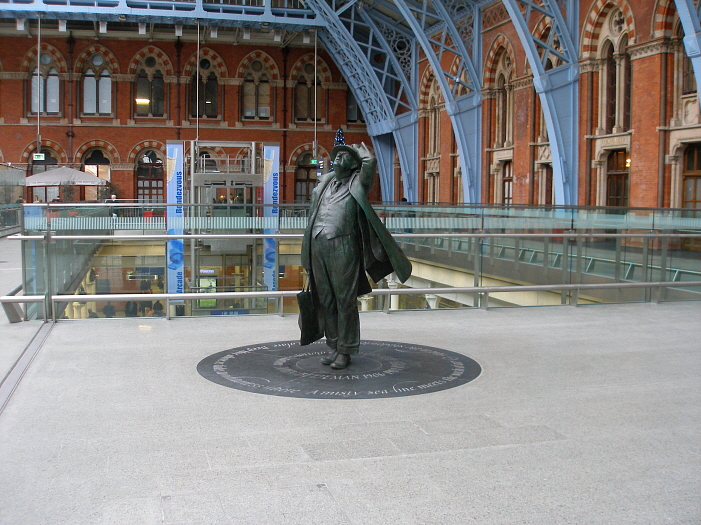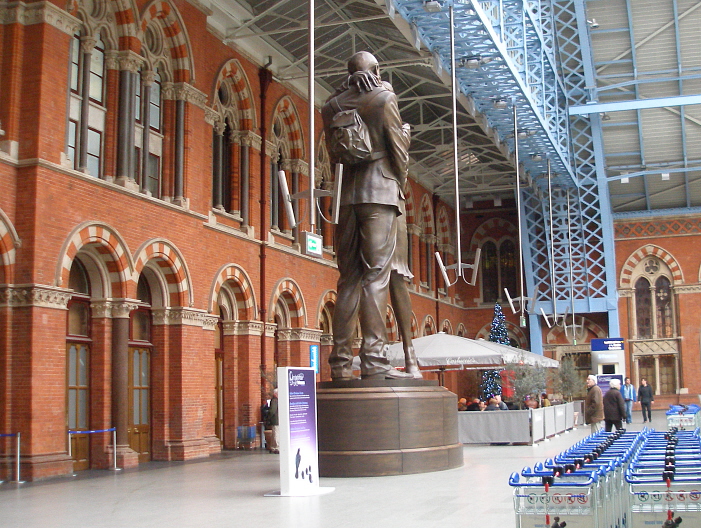
The ‘’interim’’ station initially opened with just three platform faces in use, and was signalled by Westinghouse Rail Systems, using the company’s ‘’Wescad’’ solid-state interlocking system. This is a flexible computer-based train and control system, which can accommodate changing track layouts. Accommodation was later increased to six available platforms to house terminating Thameslink services from Saturday 11th September 2004. The intention was for Midland Mainline services to make exclusive use of two platforms, Thameslink to exclusively use three platforms, whilst the sixth would be shared between the two operators. Thameslink services were terminating at St Pancras as a result of the closure of the route through Kings Cross Thameslink, which passed under the two termini on the Euston Road. As part of the entire St Pancras restoration, it was decided to complete a brand new Thameslink station, integrated with the new international terminus. The new Kings Cross St Pancras Thameslink station was priced at £63.5 million (2003 prices) and was to be accommodated in a concrete box established underneath the old St Pancras station. Construction of this began in September 2004. The existing Kings Cross Thameslink station had been criticised for the congestion it suffered as a result of narrow platforms and the limited access between the platforms and other parts of the station. The prospect of the 2012 Olympics had only compounded the reasons for a completely new station, which would offer unrivalled connections between international, domestic, and underground services for spectators at St Pancras.
After the opening of the ‘’interim’’ site, work began on demolishing all existing platforms within the Barlow trainshed, to allow the laying of a completely new concrete deck across the entire floor space, suspended upon the cast-iron columns of the undercroft. This in turn would produce the necessary strength to permit large gaps, as earlier mentioned, to be cut into the floor, allowing natural light to reach the undercroft area. The structure of the interim station was subsequently extended northwards and westwards, to cover the entirety of the St Pancras approaches and thirteen new platforms. The extension was designed under the auspices of ‘’Rail Link Engineering’’ (RLE), and transpired to be a louvre-blade glass roof suspended over the platforms. The structure was clad in places with aluminium, and measured approximately 710-feet in length by 370-feet in width. Separating the extension from the Barlow trainshed was a transept, wholly clad in glass, measuring approximately 70-feet in depth by 370-feet in width.
The most prestigious part of the project was, naturally, the restoration of Barlow’s trainshed, undertaken by ‘’Pascall & Watson Architects’’. This involved removing glazing and slate tiling, both of which were caked in diesel fumes, and the complete repainting of the wrought-iron framework. The re-glazing of the roof involved the installation of 14,080 individual panes of self-cleaning glass, arranged in a ridge-and-furrow formation, covering 8,800 m² of the trainshed’s 15,150 m² roof area. The remaining roof sections were covered with 300,000 Welsh-produced slate tiles. The framework of the trainshed used no less than 20,000 litres of Sky Blue paint. The colour originally applied for the station’s opening in 1868 was Chocolate Brown, but this was soon replaced by the brighter Sky Blue shade.
The new Thameslink station came into use underneath St Pancras on 5th May 2007, two years ahead of schedule. The international station was destined to open six months later, with much ceremony. On the night of 6th November of that year, the station was deemed formally open by HRH Queen Elizabeth II, in front of a large audience and two train formations: a Class 373 Trans Manche Super Train and a Class 395 ‘’Javelin’’ unit. The station alone had cost £800 million to refurbish and modernise, as part of a total £5200 million budget for the CTRL as a whole. Midland Mainline services had since shifted from the eastern to the western side of the station, where four new platforms were provided. The former ‘’interim’’ station accommodated three platforms destined to be used by domestic ‘’Javelin’’ services from December 2009 onwards, whilst sandwiched in-between both sites were the six international platforms. The track layout at the terminus makes use of RT60 rail: this is a heavy type of rail which is less prone to excessive fatigue compared to 133A rail, which had become the British Rail standard prior to 1996. Initially, 133A rail was to be used throughout, for it solved compatibility issues when connecting the CTRL to various points of the domestic network. However, rail cracking during construction resulted in RT60 rail being chosen as the standard type throughout the project. The international and ‘’Javelin’’ platforms are signalled from Ashford IECC (Integrated Electronic Control Centre), but the Midland Mainline platforms are controlled from West Hampstead signal box.

A second northward view again shows the spacious undercroft shopping arcade below, and the champagne bar on the right. In the background is the depressing flat-roofed trainshed extension, which measures about 785-feet long by 370-feet wide. © David Glasspool

Looking towards the heavens: Sir John Betjeman. This is an appropriate life-size statue, for Sir John Betjeman was a prominent member of the ''Victorian Society'', an architectural group which fiercely campaigned agains the demolition of Sir George Gilbert Scott's hotel masterpiece in the mid-1960s. Betjeman's influence was so great that demolition was cancelled literally days before it was due to commence and as a result, the entire station received Grade I listed status in November 1967. Betjeman was Knighted in 1969, became Poet Laureate in 1972, and died at the age of 77 in May 1984. The statue was formally unveiled by Betjeman's daughter on 13th November 2007. The words which are engraved in the circle are taken from some of Betjeman's poems. © David Glasspool

This view is of interest, because it shows the gap which exists between trainshed and hotel, requiring the presence of a separate pitched roof. Of course, of prominence is a 30-foot bronze statue depicting a couple embracing, which can be found under the main clock. The statue, which was lifted into position on 22nd October 2007, has received mixed reviews. © David Glasspool
Return to the Kent Rail Homepage or alternatively, check for Updates.
Website & Copyright information - Links - Contact the Webmaster